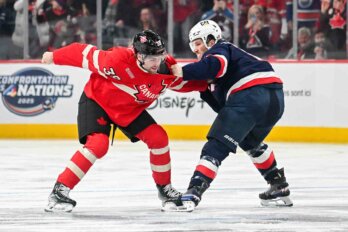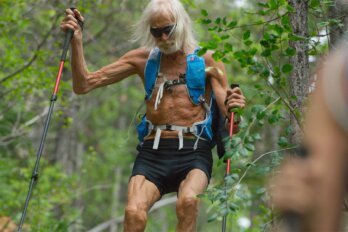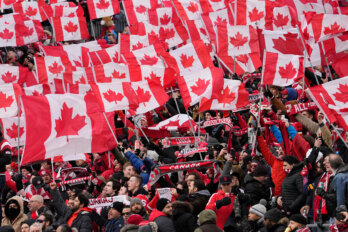They’re called “strangergrams.” That’s what twenty-four-year-old professional skateboarder Andy Anderson calls them, anyhow. Brief, Instagram-length video clips featuring Anderson skating around the streets of his hometown of White Rock, BC, or Toronto, or Montreal, or Huntington Beach, California. These videos are filmed by complete—you guessed it—strangers. He simply asks a passerby to take his phone, press the little red button as he approaches whatever piece of urban architecture has become his obstacle, and watch. In Toronto, a middle-aged woman excitedly presses the crosswalk button for him as he bolts across the street, toward the fence he subsequently leaps over. He then edited that clip and shared it with his over 230,000 Instagram followers.
The advent of social media has created a new avenue for skateboarders like Anderson to amass fans and attract sponsors. As has happened in many industries, social media has allowed skaters to sidestep the traditional models—submitting a “sponsor-me tape,” winning contests, or just being friends with the right people. Acceptance and social capital—a perceived clout of coolness—within skating are also a big part of what drives a professional’s career marketability and the amount of media coverage they receive, almost more so than on-board ability. Now, with apps like Instagram, the grassroots and the underground have direct access to centre stage, helping create a welcoming environment for those who have just picked up a board (like the Vancouver-based Late Bloomers Skate Club, which hosts inclusive in-person meetups for new skaters) and providing a new path of opportunity to skateboarders seeking notoriety or trying make a career in the industry.
There are a number of factors that contributed to the genesis of the strangergram: as a professional skater, Anderson needs to be filmed—consistent trick documentation and dissemination is generally how one appeases sponsors and grows one’s fan base; Anderson likes to skate alone, which means the usual tandem dance of skater and designated filmer isn’t possible; and, the clincher, Anderson is unnervingly nice and genuinely likes meeting new people and talking about skateboarding.
That last one is a bit unusual in the world of professional skateboarding—a pro advocating to the outsider—because skateboarding is notoriously insular and doesn’t pay much mind to what others think of it, or at least pretends as much. It’s the audience of core skaters, which spans age groups and the globe but largely still identifies with the subversive, antiauthority image of skating (Thrasher Magazine, the central text of the skateboarding community, has over 11 million followers across its social media accounts), that generally makes or breaks an upstart skateboarder’s prospects. It acts as a bellwether: if the skater’s media coverage is well received (and, these days, if they have large social media followings), it can signal to brands the marketing value of the rider.
That core group, as opposed to looky-loos on the street, is the people who’ll likely be buying the product the skater represents, which is why working to sway laypeople could be seen as a wasted effort. For years, Tony Hawk was seen as uncool among the core for bringing skateboarding from a niche culture into the mainstream via his hit video game franchise, media appearances, and corporate sponsors. A corny Bagel Bites commercial earned Hawk the stinging title of “sell-out” from fellow pros. (Hawk has since seen a turnaround in public perception—time, and perhaps becoming a popular Twitter persona, healing of some of those wounds.)
That accusation of selling out might seem warranted if your view of skateboarding is through the rose-coloured lens of punk, subversion, and “pure freedom of expression” it used to see itself through. But skateboard culture tends to swing more cynical than disruptive, built on a nebulous framework of unwritten rules—holding your board by its truck is a sin called a “mall grab,” an epithet tossed at those who tote boards around as fashion accessories—that have had a real effect on those with smaller platforms than Hawk, almost on a cruel whim. Its media outlets can even be its arbiters.
Thrasher Magazine and its late editor, Jake Phelps, famously refused to cover skaters they thought were uncool, and the publication would antagonize these skaters for any variety of reasons. In the infamous case of former pro Billy Pepper—whom Thrasher had put at number four on its list of “15 Most Hated Skaters”—this led to Phelps catching a punch in the face and Pepper earning himself a permanent print ban.
In Anderson’s case, when it comes to these arbitrary rules, he finds himself in violation of most of them. But, surprisingly, this hasn’t hampered him in the way one would expect. Anderson turned professional last year and has had a full-page spread in Thrasher. This could be a one-off or a sign of a cultural shift.
The transgression that’s top of mind for Anderson’s critics? He wears a helmet. Even though skateboarding is inherently dangerous, machismo and aesthetics often outweigh safety—helmets are generally seen as a blight on footage and photographs of skateboarding tricks, especially in street skating. The raw appeal of grinding marble ledges in city plazas is compromised when juxtaposed with the sanitized plastic bubbles of padding that serve as protection from the natural urban elements the skateboarder is meeting with. In Pedro Delfino’s “Welcome to Deathwish” video, he knocks himself unconscious attempting tricks, and the blurb on Thrasher’s website, where the video is hosted, proclaims, “The slams are brutal, but the legendary makes validate the pain.” Spilling blood is seen as paying penance before the salvation of riding away from a trick.
Anderson says wearing a helmet has cost him sponsorships. He’s seen some criticism online, and he’s even heard it from well-meaning friends, but he’s simply let it ding right off of said helmet. He just feels better wearing it.
Then there are the tricks Anderson does. They are an intensely creative and incredibly difficult pastiche of manoeuvres from all three main disciplines of skateboarding: street, transition, and freestyle. However, this collage tends to fall into the scarlet-letter category of “dorky” given that skating stays afloat on waves of trends—from fashion to what type of tricks are “in”—that Anderson mostly avoids. In the early to mid-2000s, for instance, wearing skin-tight pants and grinding down giant handrails was in vogue.
By the mid-to-late 2010s, the pluming, JNCO-adjacent jeans that had characterized the ’90s skate scene were back, and house music was the soundtrack du jour of videos. Not following what’s popular has negatively affected skaters of a similar ilk to Anderson. Richie Jackson, who dresses like a ’70s university professor studying psychedelics and does previously unthinkable tricks, like riding down a set of stairs on the underside of his skateboard, has faced serious criticism for his skating and even bullying by fellow pro skaters.
Anderson, however, has mostly avoided that acrid reception, and perhaps even superseded it, thanks to his out-there on-board abilities. Not only can he take his skateboard down twenty-nine-stair handrails and do hypertechnical manuals (tricks where the board is balanced on two wheels)—hallmarks of street skateboarding—but he excels at transition, flying around giant concrete bowls with the literal best of them, and he’s even a freestyle skateboarding world champion (freestyle being, in essence, a cross between skateboarding and figure skating, where skaters plan and execute routines to music).
To be at the highest level of all three disciplines, like Anderson is, is incredibly rare, as is how he then takes pieces of each and stitches them together to create hybrid tricks. In a YouTube video detailing his personal philosophy around skating, which has over 300,000 views, he compares his process of learning to skate to learning a language: once you know a few, the patterns of others become easier to see and adopt.
Anderson likes to meditate on the act of skateboarding. In the same video, when ruminating on one of the most contentious questions in skateboarding today—whether or not the act of riding a board is a sport—Anderson explores the definition of the word toy: something you play with that has “no objective.” Add an objective? It becomes a puzzle, “like a Rubik’s Cube.” Add multiple players and it turns into a game or a sport. But Anderson sees skateboarding as a puzzle: “Something that you’re playing with that you’re constantly trying to figure out more about. It’s a constant discovery.”
Now, Anderson is hoping to solve that puzzle in front of the world. He’s currently one of Canada Skateboard’s “targeted athletes” to qualify for and potentially represent his country at the Tokyo Olympics in 2021—skateboarding’s first-ever year as an Olympic event (which was recently postponed due to COVID-19). Anderson would potentially be competing against some of the world’s best, formidable mainstream names like Nyjah Huston and Yuto Horigome.
Considering all of Anderson’s perceived transgressions, how has he managed to become pro for Powell-Peralta, one of skating’s original stalwart brands, and be on the verge of competing at the Olympics? According to Ben Stoddard, president of Canada Skateboard, it’s been through his sheer skateboarding ability, a constant and growing online presence, and just carrying himself well over his extensive travels. “Regardless of if Andy becomes an Olympic athlete,” Stoddard says, “he’s done more for promoting and growing skateboarding in Canada over the last couple of years than the majority of Canadian skateboarders.”
It comes back to social media. Platforms like Instagram and YouTube have helped democratize skateboarding media (likely contributing to the downfall of its traditional outlets) and invited in an entirely new audience unaware of skateboarding’s “rules.” This has made it possible for core skaters to be exposed to Anderson in the way he wants to be presented, widening skateboarding’s Overton window. This formula has also been integral to the recent rise of women’s skating: companies started catching on to the large followings women skaters had amassed online—finally, after a frustratingly long time, noticing their marketability. Briana King parlayed her rapidly growing Instagram account, which exploded after she began organizing women and LGBTQ skate sessions via the app, into sponsorships, and this fan base even helped take her skate clinics international. King, who now has over 100,000 followers, appears in an episode of a popular YouTube skateboarding vlog with Anderson. Together, they skate on top of the smooth surface of a rock protruding from the choppy waters of the Pacific. They’ve both managed to navigate around, and in some cases reconfigure, a sponsorship model that traditionally ignored them, and they did it in large part by using social media to demonstrate their worth.
Anderson credits a lot of his success to an underpinning of human connection, to being “so open with his thought process.” He believes his skate-philosophy videos help people relate “more to a person than to a trick.” Strangergrams do the same. His positivity and passion are evident, infectious. At a freestyle world championship in Tokyo (which he won), he met a group of skaters who were so enamoured with him and his approach that they wound up naming their skateboard shop, Abby, after the refurbished ambulance Anderson once lived in.
It’s not all roses yet, though. Skateboarding is a lucrative endeavour only for the select few at the top. Powell-Peralta has helped ease some of Anderson’s financial woes, but he still had to pay his own way to most Olympic qualifying events. And, once he arrived at the contests, judges seemed confused about how to score Anderson’s style of skating. It’s unquestionably at a high level, but it is so far outside the norm of what they generally see that it’s hard to put into context—like a tennis player returning a serve with the handle of their racket. It’s objectively harder, but it’s tough to get past the “Why would you do that?” of it all. At a Street League Skateboarding event in London, England, the announcers were at a loss about what to even call his manoeuvres. Anderson likens this to “judging an abstract painting against a realist painting.”
Anderson thinks it’ll just take some time for the competitive skateboarding world to understand his approach. (And, thanks to the Tokyo 2020 postponement, time is something he’s certainly got more of.) He says he’s more concerned with learning “how to get to that level” of Olympic-calibre skating. And, if he does, Anderson wants to use that platform to showcase the full breadth of creativity that skateboarding offers—a mirror of what he already does, on a smaller scale, online. Anderson wants to be on the biggest stage in sports, advocating for the outsiders in his own. “My goal with the Olympics isn’t to win a gold medal,” he says. “I want to make sure that somebody is standing up for that weird kid who still wants to make it.”




